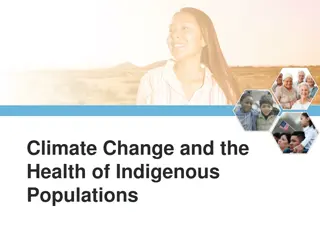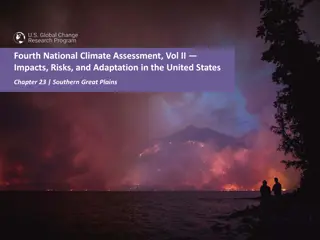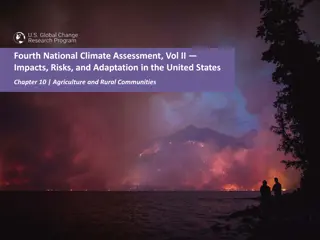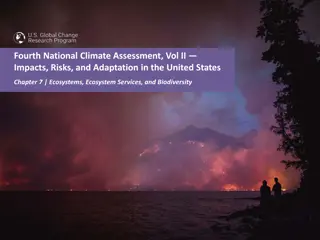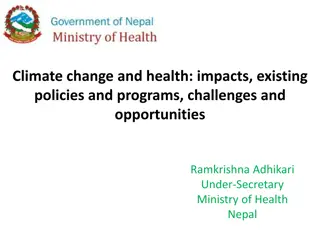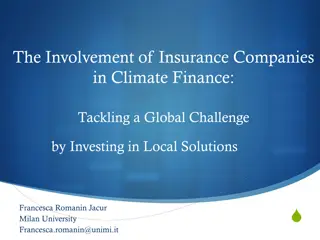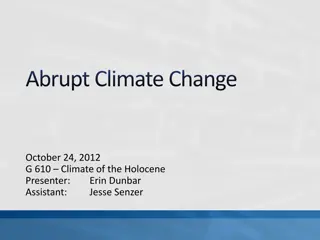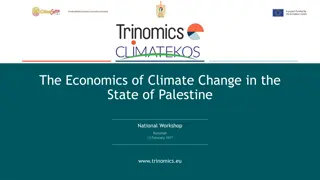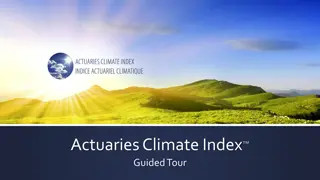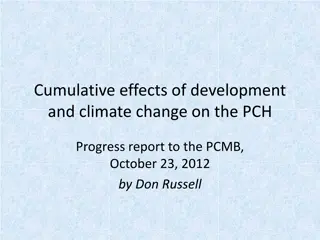Impacts of Climate Change on Human Health in the United States
Climate change poses a significant threat to the health and well-being of Americans, with adverse consequences projected to worsen. It impacts human health by increasing exposure to extreme events, infectious diseases, and air, food, and water quality changes. Vulnerable populations, including children, older adults, low-income communities, and communities of color, face disproportionate health risks. Proactive adaptation measures can reduce these risks and improve health outcomes, while lowering greenhouse gas emissions would result in substantial health and economic benefits.
Download Presentation

Please find below an Image/Link to download the presentation.
The content on the website is provided AS IS for your information and personal use only. It may not be sold, licensed, or shared on other websites without obtaining consent from the author. Download presentation by click this link. If you encounter any issues during the download, it is possible that the publisher has removed the file from their server.
E N D
Presentation Transcript
Fourth National Climate Assessment, Vol II Impacts, Risks, and Adaptation in the United States Chapter 14 | Human Health Fourth National Climate Assessment, Vol II Impacts, Risks, and Adaptation in the United States nca2018.globalchange.gov 1
Ch. 14 | Human Health Key Message #1 14 Climate Change Affects the Health of All Americans The health and well-being of Americans are already affected by climate change, with the adverse health consequences projected to worsen with additional climate change. Climate change affects human health by altering exposures to heat waves, floods, droughts, and other extreme events; vector-, food- and waterborne infectious diseases; changes in the quality and safety of air, food, and water; and stresses to mental health and well-being. Fourth National Climate Assessment, Vol II Impacts, Risks, and Adaptation in the United States nca2018.globalchange.gov 2
Ch. 14 | Human Health Key Message #2 14 Exposure and Resilience Vary Across Populations and Communities People and communities are differentially exposed to hazards and disproportionately affected by climate-related health risks. Populations experiencing greater health risks include children, older adults, low- income communities, and some communities of color. Fourth National Climate Assessment, Vol II Impacts, Risks, and Adaptation in the United States nca2018.globalchange.gov 3
Ch. 14 | Human Health Key Message #3 14 Adaptation Reduces Risks and Improves Health Proactive adaptation policies and programs reduce the risks and impacts from climate-sensitive health outcomes and from disruptions in healthcare services. Additional benefits to health arise from explicitly accounting for climate change risks in infrastructure planning and urban design. Fourth National Climate Assessment, Vol II Impacts, Risks, and Adaptation in the United States nca2018.globalchange.gov 4
Ch. 14 | Human Health Key Message #4 14 Reducing Greenhouse Gas Emissions Results in Health and Economic Benefits Reducing greenhouse gas emissions would benefit the health of Americans in the near and long term. By the end of this century, thousands of American lives could be saved and hundreds of billions of dollars in health-related economic benefits gained each year under a pathway of lower greenhouse gas emissions. Fourth National Climate Assessment, Vol II Impacts, Risks, and Adaptation in the United States nca2018.globalchange.gov 5
Ch. 14 | Human Health Fig. 14.1: Climate Change and Health This conceptual diagram illustrates the exposure pathways by which climate change could affect human health. Exposure pathways exist within the context of other factors that positively or negatively influence health outcomes (gray side boxes). Key factors that influence vulnerability for individuals are shown in the right box and include social determinants of health and behavioral choices. Key factors that influence vulnerability at larger scales, such as natural and built environments, governance and management, and institutions, are shown in the left box. The extent to which climate change could alter the burden of disease in any location at any point in time will depend not just on the magnitude of local climate change but also on individual and population vulnerability, exposure to changing weather patterns, and capacity to manage risks, which may also be affected by climate change. Source: Balbus et al. 2016.2 Fourth National Climate Assessment, Vol II Impacts, Risks, and Adaptation in the United States nca2018.globalchange.gov 6
Ch. 14 | Human Health Fig. 14.2: Vulnerable Populations Examples of populations at higher risk of exposure to adverse climate-related health threats are shown along with adaptation measures that can help address disproportionate impacts. When considering the full range of threats from climate change as well as other environmental exposures, these groups are among the most exposed, most sensitive, and have the least individual and community resources to prepare for and respond to health threats. White text indicates the risks faced by those communities, while dark text indicates actions that can be taken to reduce those risks. Source: EPA. Fourth National Climate Assessment, Vol II Impacts, Risks, and Adaptation in the United States nca2018.globalchange.gov 7
Ch. 14 | Human Health Fig. 14.3: Hospitals at Risk from Storm Surge by Hurricanes These maps show the locations of hospitals in (top) Charleston County, South Carolina, and (bottom) Miami-Dade County, Florida, with respect to storm surge inundation for different categories of hurricanes making landfall at high tide. Colors indicate the lowest category hurricane affecting a given location, with darker blue shading indicating areas with the greatest susceptibility to flooding and darker red dots indicating the most vulnerable hospitals. Four of the 38 (11%) hospitals in Miami-Dade County face possible storm surge inundation following a Category 2 hurricane; this could increase to 26 (68%) following a Category 5 hurricane. Charleston hospitals are more exposed to inundation risks. Seven of the 11 (64%) hospitals in Charleston County face possible storm surge inundation following a Category 2; this could increase to 9 (82%) following a Category 4. The impacts of a storm surge will depend on the effectiveness of resilience measures, such as flood walls, deployed by the facilities. Data from National Hurricane Center 2018152and the Department of Homeland Security 2018.153 Fourth National Climate Assessment, Vol II Impacts, Risks, and Adaptation in the United States nca2018.globalchange.gov 8
Ch. 14 | Human Health Fig. 14.4: Projected Change in Annual Extreme Temperature Mortality The maps show estimated changes in annual net mortality due to extremely hot and cold days in 49 U.S. cities for 2080 2099 as compared to 1989 2000. Across these cities, the change in mortality is projected to be an additional 9,300 deaths each year under a higher scenario (RCP8.5) and 3,900 deaths each year under a lower scenario (RCP4.5). Assuming a future in which the human health response to extreme temperatures in all 49 cities was equal to that of Dallas today (for example, as a result of availability of air conditioning or physiological adaptation) results in an approximate 50% reduction in these mortality estimates. For example, in Atlanta, an additional 349 people are projected to die from extreme temperatures each year by the end of century under RCP8.5. Assuming residents of Atlanta in 2090 have the adaptive capacity of Dallas residents today, this number is reduced to 128 additional deaths per year. Cities without circles should not be interpreted as having no extreme temperature impact. Data not available for the U.S. Caribbean, Alaska, or Hawai i & U.S.-Affiliated Pacific Islands regions. Source: adapted from EPA 2017.157 Fourth National Climate Assessment, Vol II Impacts, Risks, and Adaptation in the United States nca2018.globalchange.gov 9
Ch. 14 | Human Health Chapter Author Team 14 Gregory Glass, University of Florida Shubhayu Saha, Centers for Disease Control and Prevention Mark M. Shimamoto, American Geophysical Union Juli Trtanj, National Oceanic and Atmospheric Administration Jalonne L. White-Newsome, The Kresge Foundation Federal Coordinating Lead Authors John M. Balbus, National Institute of Environmental Health Sciences George Luber, Centers for Disease Control and Prevention Chapter Lead Kristie L. Ebi, University of Washington Chapter Authors Aparna Bole, University Hospitals Rainbow Babies & Children s Hospital, Ohio Allison Crimmins, U.S. Environmental Protection Agency Review Editor David D Onofrio, Atlanta Regional Commission Fourth National Climate Assessment, Vol II Impacts, Risks, and Adaptation in the United States nca2018.globalchange.gov 10
Ch. 14 | Human Health Acknowledgments 14 Technical Contributor Stasia Widerynski, Centers for Disease Control and Prevention USGCRP Coordinators Ashley Bieniek-Tobasco, Health Program Coordinator Sarah Zerbonne, Adaptation and Decision Science Coordinator Natalie Bennett, Adaptation and Assessment Analyst Christopher W. Avery, Senior Manager Fourth National Climate Assessment, Vol II Impacts, Risks, and Adaptation in the United States nca2018.globalchange.gov 11
Recommended chapter citation Ebi, K.L., J.M. Balbus, G. Luber, A. Bole, A. Crimmins, G. Glass, S. Saha, M.M. Shimamoto, J. Trtanj, and J.L. White-Newsome, 2018: Human Health. In Impacts, Risks, and Adaptation in the United States: Fourth National Climate Assessment, Volume II [Reidmiller, D.R., C.W. Avery, D.R. Easterling, K.E. Kunkel, K.L.M. Lewis, T.K. Maycock, and B.C. Stewart (eds.)]. U.S. Global Change Research Program, Washington, DC, USA. doi: 10.7930/NCA4.2018.CH14 Read the full chapter https://nca2018.globalchange.gov/chapter/health nca2018.globalchange.gov Fourth National Climate Assessment, Vol II Impacts, Risks, and Adaptation in the United States nca2018.globalchange.gov 12






